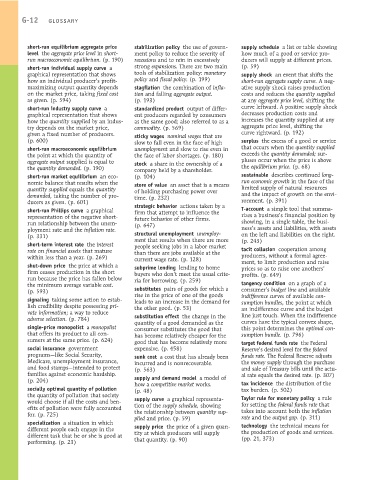Page 908 - Krugmans Economics for AP Text Book_Neat
P. 908
G-12 GLOSSARY
short-run equilibrium aggregate price stabilization policy the use of govern- supply schedule a list or table showing
level the aggregate price level in short- ment policy to reduce the severity of how much of a good or service pro-
run macroeconomic equilibrium. (p. 190) recessions and to rein in excessively ducers will supply at different prices.
short-run individual supply curve a strong expansions. There are two main (p. 59)
graphical representation that shows tools of stabilization policy: monetary supply shock an event that shifts the
how an individual producer’s profit- policy and fiscal policy. (p. 199) short-run aggregate supply curve. A neg-
maximizing output quantity depends stagflation the combination of infla- ative supply shock raises production
on the market price, taking fixed cost tion and falling aggregate output. costs and reduces the quantity supplied
as given. (p. 594) (p. 193) at any aggregate price level, shifting the
short-run industry supply curve a standardized product output of differ- curve leftward. A positive supply shock
graphical representation that shows ent producers regarded by consumers decreases production costs and
how the quantity supplied by an indus- as the same good; also referred to as a increases the quantity supplied at any
try depends on the market price, commodity. (p. 569) aggregate price level, shifting the
given a fixed number of producers. sticky wages nominal wages that are curve rightward. (p. 192)
(p. 600) slow to fall even in the face of high surplus the excess of a good or service
short-run macroeconomic equilibrium unemployment and slow to rise even in that occurs when the quantity supplied
the point at which the quantity of the face of labor shortages. (p. 180) exceeds the quantity demanded; sur-
aggregate output supplied is equal to stock a share in the ownership of a pluses occur when the price is above
the quantity demanded. (p. 190) company held by a shareholder. the equilibrium price. (p. 68)
short-run market equilibrium an eco- (p. 104) sustainable describes continued long-
nomic balance that results when the store of value an asset that is a means run economic growth in the face of the
quantity supplied equals the quantity of holding purchasing power over limited supply of natural resources
demanded, taking the number of pro- time. (p. 232) and the impact of growth on the envi-
ducers as given. (p. 601) ronment. (p. 391)
strategic behavior actions taken by a
short-run Phillips curve a graphical firm that attempt to influence the T-account a simple tool that summa-
representation of the negative short- future behavior of other firms. rizes a business’s financial position by
run relationship between the unem- (p. 647) showing, in a single table, the busi-
ployment rate and the inflation rate. ness’s assets and liabilities, with assets
(p. 331) structural unemployment unemploy- on the left and liabilities on the right.
ment that results when there are more (p. 243)
short-term interest rate the interest people seeking jobs in a labor market
rate on financial assets that mature than there are jobs available at the tacit collusion cooperation among
within less than a year. (p. 269) current wage rate. (p. 128) producers, without a formal agree-
shut-down price the price at which a subprime lending lending to home ment, to limit production and raise
prices so as to raise one anothers’
firm ceases production in the short buyers who don’t meet the usual crite- profits. (p. 649)
run because the price has fallen below ria for borrowing. (p. 259)
the minimum average variable cost. tangency condition on a graph of a
(p. 593) substitutes pairs of goods for which a consumer’s budget line and available
rise in the price of one of the goods indifference curves of available con-
signaling taking some action to estab- leads to an increase in the demand for sumption bundles, the point at which
lish credibility despite possessing pri- the other good. (p. 53) an indifference curve and the budget
vate information; a way to reduce line just touch. When the indifference
adverse selection. (p. 784) substitution effect the change in the
quantity of a good demanded as the curves have the typical convex shape,
single-price monopolist a monopolist consumer substitutes the good that this point determines the optimal con-
that offers its product to all con- has become relatively cheaper for the sumption bundle. (p. 796)
sumers at the same price. (p. 624) good that has become relatively more target federal funds rate the Federal
social insurance government expensive. (p. 458) Reserve’s desired level for the federal
programs—like Social Security, sunk cost a cost that has already been funds rate. The Federal Reserve adjusts
Medicare, unemployment insurance, incurred and is nonrecoverable. the money supply through the purchase
and food stamps—intended to protect (p. 563) and sale of Treasury bills until the actu-
families against economic hardship. al rate equals the desired rate. (p. 307)
(p. 204) supply and demand model a model of
how a competitive market works. tax incidence the distribution of the
socially optimal quantity of pollution (p. 48) tax burden. (p. 502)
the quantity of pollution that society Taylor rule for monetary policy a rule
would choose if all the costs and ben- supply curve a graphical representa- for setting the federal funds rate that
efits of pollution were fully accounted tion of the supply schedule, showing takes into account both the inflation
for. (p. 725) the relationship between quantity sup-
plied and price. (p. 59) rate and the output gap. (p. 311)
specialization a situation in which technology the technical means for
different people each engage in the supply price the price of a given quan- the production of goods and services.
different task that he or she is good at tity at which producers will supply (pp. 21, 373)
performing. (p. 23) that quantity. (p. 90)

